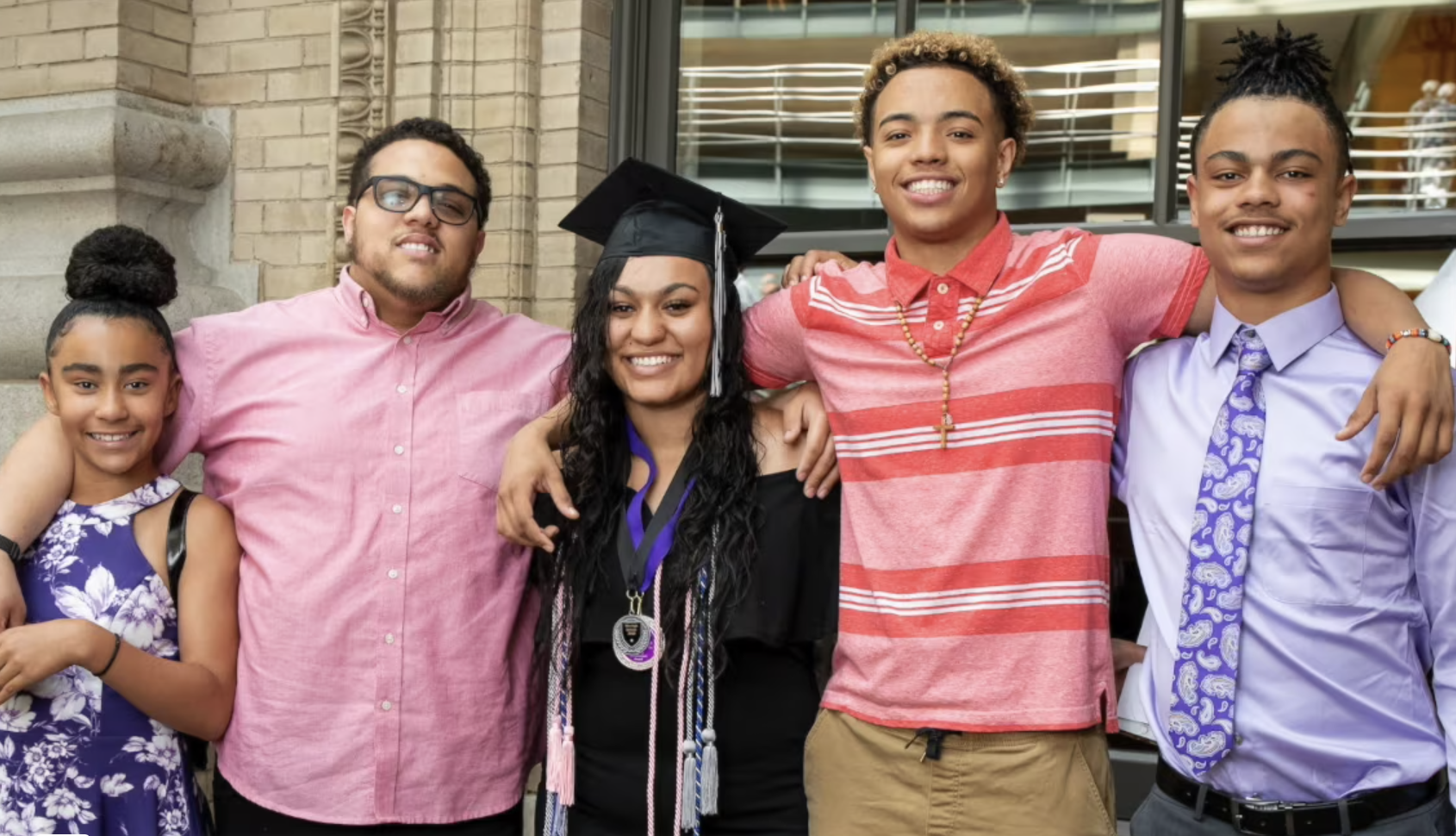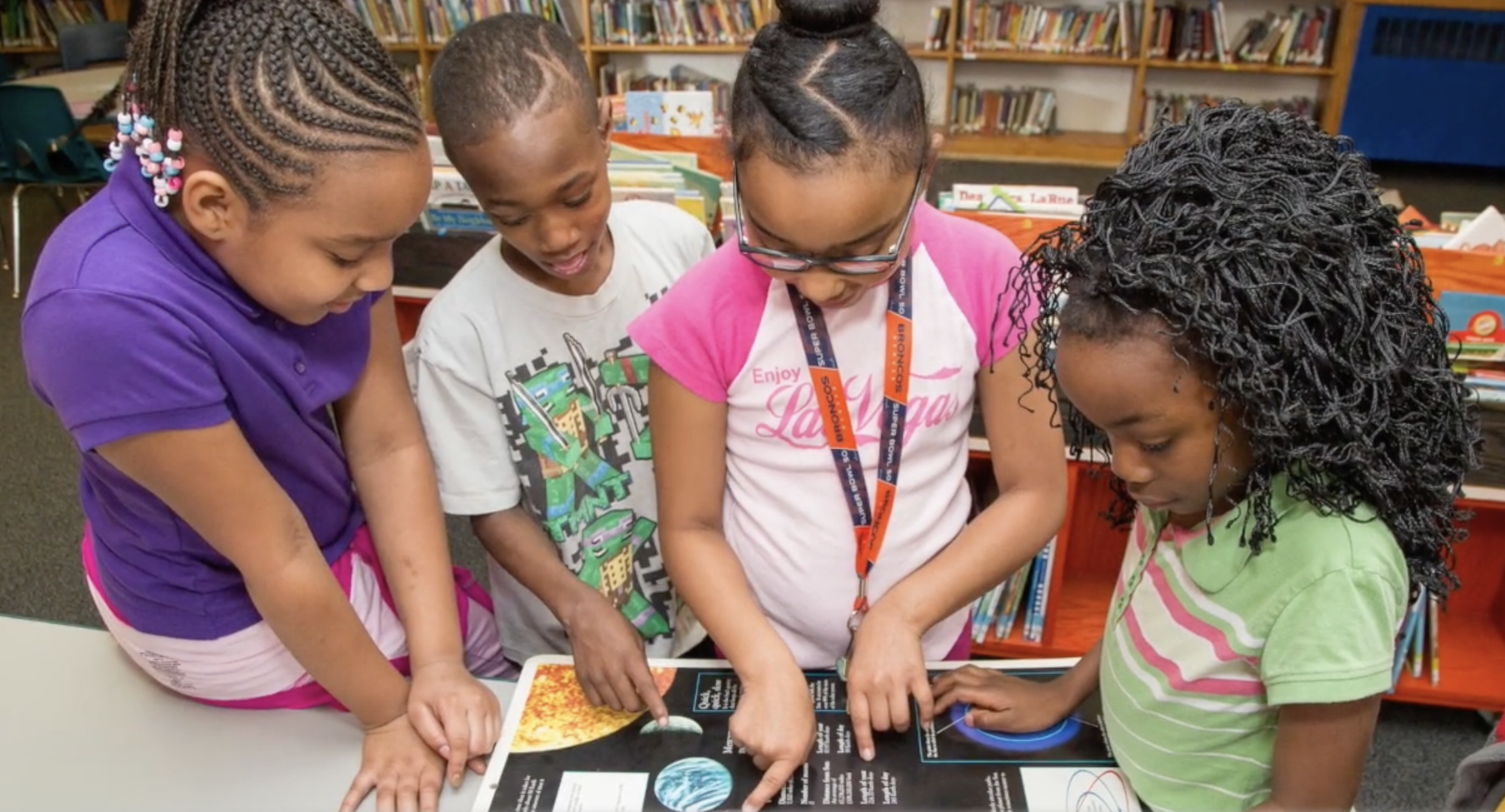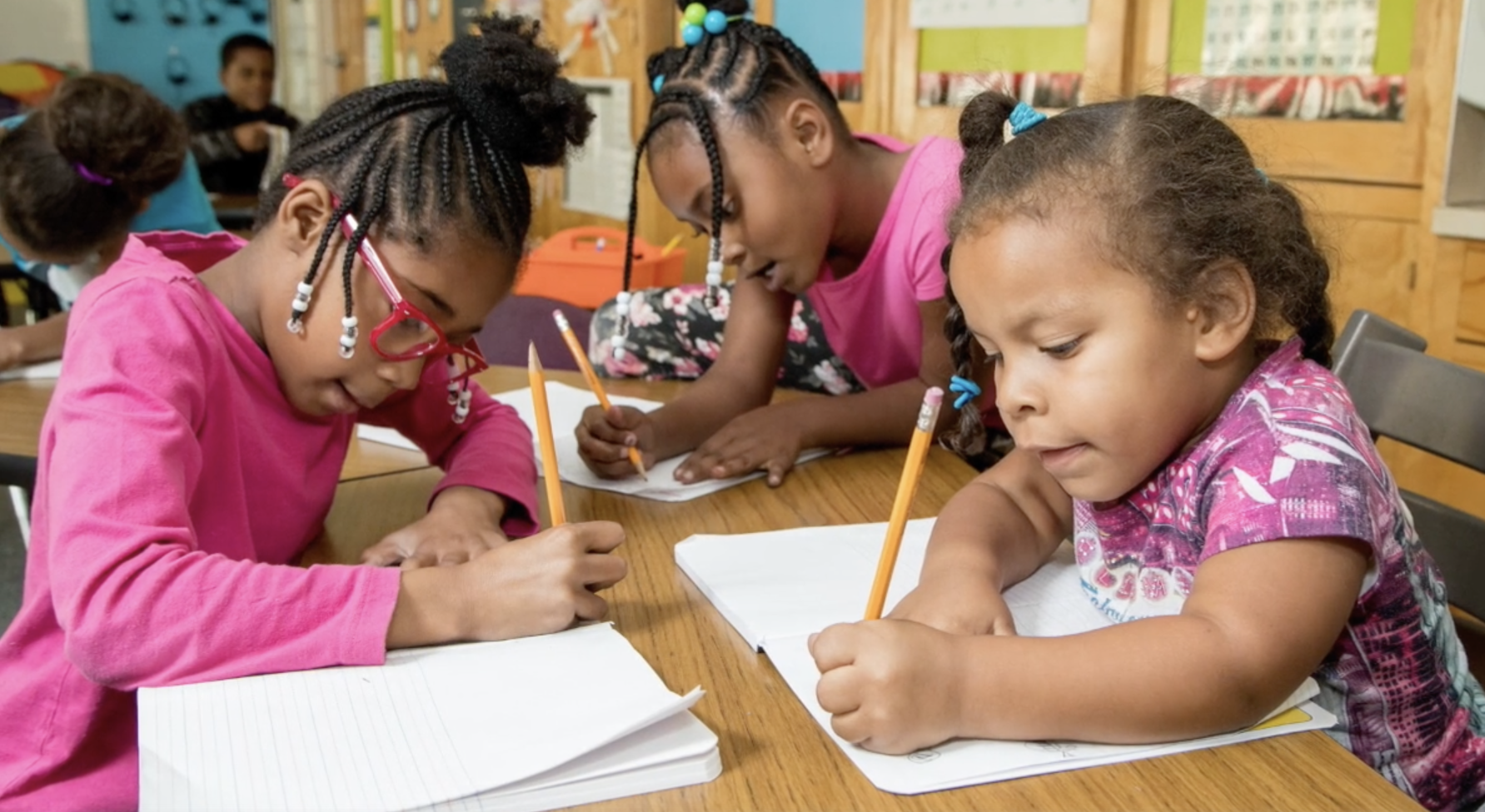
Denver Public Schools/Vimeo

Audio By Carbonatix
Back in 2019, the Denver Public Schools Board of Education passed a Black Excellence Resolution designed to improve the educational experience and outcomes for Black students in DPS. It was the result of “years of concern from families and communities,” the district tells Westword, and a “collective response” to those concerns.
Don’t look at the BER as a program with a set end date, explains Leslie Juniel, executive director of the DPS Culture, Learning and Development Team (CLD), which heads the efforts, but rather “a way of living” and “part of the DPS culture.”
“All schools now have a Black Excellence Plan focused on improving the daily experiences of our students, families and team members,” Juniel and the CLD team note.
For Black History Month, the district shared information online about the BER and the upcoming rollout of a Black Student Success Team. But not before a supposed DPS “Black Excellence Pledge” came under attack nationally.
“Disgusting racists,” wrote conservative firebrand Megyn Kelly in response to a January 11 post by the right-wing account @EndWokeness on X, showing a DPS document titled “DPS Belief in and Commitment to Black Excellence.”
Will you step up to support Westword this year?
At Westword, we’re small and scrappy — and we make the most of every dollar from our supporters. Right now, we’re $22,750 away from reaching our December 31 goal of $50,000. If you’ve ever learned something new, stayed informed, or felt more connected because of Westword, now’s the time to give back.
Disgusting racists. https://t.co/5RUGVdP0zX
— Megyn Kelly (@megynkelly) January 12, 2024
The post was soon viewed by 1.8 million people, sparking backlash and callouts of DPS. The account claimed the “internal memo” had just been sent to DPS staff and teachers.
But according to DPS Communications Director Scott Pribble, it’s a public document that dates back to when the BER was adopted five years ago. “The document is from a long time ago,” Pribble says.
Describing it as a “Black Excellence Pledge,” @EndWokeness claimed the document says “all whites are racist and perpetuate racist ideologies, policies, & practices.”
What it actually says is this: “All educators need to deeply understand white supremacy, white privilege and the prevalence and deep harm ‘whiteness’ brings to students and staff.” The document also states that DPS staffers must acknowledge that “institutional racism exists in Denver Public Schools, and at all levels.” And if they think “I am not a racist,” they are instructed to refer back to a quote from author Robin Diangello: “It is not if you are racist, but how you are racist.”
The document adds, “We all perpetuate racist ideologies, policies and practices in some way and must work tirelessly in our efforts to be anti-racist.”
Why would this document upset people?
“You’d have to ask a white person or anybody else who would be resistant to this why they are that,” Juniel says. “Because who is against lifting up students? Who is against students achieving and having a future and being supported to be successful? Who is against that? I would ask those people to think about why they are, beyond the surface of what politics and culture wars are happening. These are people’s lives. This work is life and death, literally and figuratively. So I don’t know who would be against that, but I would ask them to dig deep and figure out why.”
The outraged responses from talking heads like Kelly just comes with the territory, Juniel says: “The work has been made toxic because it’s been politicized.”
Much of the recent outrage has focused on what critics claim is a lifting of Black students and “racist” disregard for white students – a claim that Juniel and other DPS leaders have heard for years, even before the BER was a thing.
“School leaders were being asked questions such as, ‘Why are we focused on Black kids?'” recalls Michael Sykes, director of the DPS Culture, Equity and Leadership Team (one of three groups that make up the CLD). “And that is a really triggering question, especially for Black parents and family members.”
One of the BER’s big wins, says Juniel, is that these sorts of questions don’t come up as much anymore. “You can see, it has had a significant impact,” she adds. “People have begun to understand why there is a focus.”
Still, reports have emerged over the years since the BER was adopted that DPS students are still experiencing microaggressions and incidents that make them feel uncomfortable, along with being underrepresented in honors and AP classes at certain schools.
Then there’s the data. “It speaks for itself,” according to the CLD team.
Colorado data shows that the four-year graduation rate for Black students enrolled in DPS schools was 73.4 percent for the 2021-2022 school year; the rate for white students was 86.4 percent. The dropout rate for Black DPS students during that period was 4.2 percent, while the rate for white students was 1.8 percent.
During the 2022-2023 school year, a total of 88,235 students were enrolled in DPS, and 11,609 – a little over 13 percent – were Black. The achievement gap between Black and white students on the 2023 CMAS state literacy tests for grades three through eight was 43 percent in math, a decrease of 20 percent from 2021-2022, and 32 percent in literacy, an increase of 4 percent from 2021-2022.
“We continue to see disproportionate numbers of Black students over-referred to discipline and special education, yet under-referred to rigorous learning opportunities such as AP and gifted and talented,” the CLD team tells Westword. “It is important that we continue the Black Excellence Resolution work, because it puts a laser focus on this reality, and to not address it or ignore it would be educational malpractice on our part.”

Auon’tai Anderson has also turned his attention to elevating Black Excellence in schools.
Center for Advancing Black Excellence in Education
Former DPS board vice president Auon’tai Anderson, who now runs the new Center for Advancing Black Excellence in Education, believes the district and Colorado’s education sector as a whole are barely beginning to scratch the surface of what “Black Excellence” truly means and looks like in the school system.
It’s bigger than just implementing a resolution: “You have to make sure that it’s fulfilled to its totality, period – full stop,” Anderson says.
“There should be no reason why we are celebrating the achievement of Black students by moving up on the scale 3 to 5 percent,” he tells Westword. “Black students should learn at the same proficiency levels as their white counterparts. We have not forced the system to really change. But also, we have to stop acting in a deficit mindset that people should feel bad for Black children because of the struggles of our ancestors.”
Anderson, who decided not to run for re-election to the DPS board and up until early last month was vying for the House District 8 seat held by term-limited incumbent Leslie Herod, describes the DPS efforts in recent years as arriving in “seasons,” when community members and school leaders will “demand better for Black children and Black educators,” but then no big systemic or educational changes actually happen.
“It’s come in multiple cycles,” Anderson explains. “One season was the Dr. Sharon Bailey report (2016), then the next season was the Black Excellence Resolution (2019), and then it was the summer of 2020. And really, since then, we have shifted the spotlight and focus off of all three of those major seasons because something else catches our attention and we often forget the work that we’re doing to support our Black students.”
The Bailey report – titled “An Examination of Student and Educator Experiences in Denver Public Schools Through the Voices of African-American Teachers and Administrators” – uncovered numerous issues within the DPS system, including a lack of “qualified, diverse, culturally competent teachers” and Black role models; disproportionate discipline when it comes to suspensions and expulsions; “low expectations/deficit thinking” regarding Black students; lack of access to “quality enrichment, academic and support programs”; and a lack of “culturally relevant curriculum and pedagogy.” These findings ultimately led to the adoption of the BER.
One particular problem that Anderson believes doesn’t get talked about enough is lumping the struggles of Black students into the “same pot as all students of color.” Colorado’s education system and DPS, specifically, has grown “comfortable” and “okay” with doing this, he says.
Out of the seven races and ethnicities recognized by DPS in recent state data, Black students have the third-lowest four-year graduation rate – ahead of just American Indians and Alaskan Natives (50 percent), who are recorded as a single group, and Native Hawaiian or Other Pacific Islanders (50 percent).
There are only 1,213 students who identify as American Indian and Alaskan Native and Native Hawaiian or Other Pacific Islanders in all of DPS for the 2023-2024 school year, compared to the nearly 12,000 Black students who are enrolled. DPS reports a total of 45,668 Hispanic students; 4,521 “two or more races” students; and 2,727 Asian students.
In the entire state of Colorado, there are only 40,063 Black students enrolled for the 2023-2024 school year compared to the 396,277 students who identify as other races and ethnicities. A total of 312,605 of those are Hispanic.
“When we put Black kids into that same pot, Black students go to the bottom and are never looked at,” Anderson charges. “And that is just not something that I can continue to endorse. You can’t just keep throwing Black students into that all- students-of-color pot. Our experiences are different, our needs are different. When you throw Black students into that pot, you lose them, because they just go down to the bottom.”

DPS has been actively working to establish a Black Student Success Team intended to help youths at all school levels.
Denver Public Schools/Vimeo
One way that DPS has been trying to mitigate this is by the formation of the Black Student Success Team, which was unveiled last October 2023 and is aimed at “increasing Black student achievement and highlighting Black Student successes in DPS schools,” the CLD team says.
DPS is working with researchers from the University of Denver to identify district practices that might help improve a Black student’s trajectory in school; while the project is still in the “discovery phase,” things are expected to pick up later this year.
“The strategic work and focus on Black students within these schools is set to begin in August of the 2024-2025 school year,” says Michael Atkins, director of the Black Student Success Team and former principal at Stedman Elementary. “We are looking forward to DU sharing their findings and helping us identify trends.”
Some of the specific things the team will be looking to improve include the graduation rates of Black students, grade-level performance, enrollment in “rigorous classes” and the feeling of safety and support in the DPS school system, according to CLD leaders.
For the BER, the team says it is continuing to provide “learning opportunities for our team members for reflection on mindsets and behaviors that perpetuate systems of oppression, the impact it has on others and how to pivot/adjust.” Its message to white people who can’t find it in their hearts to support Black Excellence in Denver Public Schools: “Why?”
“It is unclear to us why anyone would be resistant to the work of cultivating the very best academic experience we can for students who have for too long been invisible and underserved,” the CLD team says. “We know that when we design systems, structures and practices for those who are most marginalized, all students benefit.”
Asked why he thinks elevating Black students and addressing racism in the education system bothers a lot of white people, Anderson says: “These individuals have grown up in a culture of not accepting or being forced to accept Blackness. … They have grown up with not needing to accept the Black experience. … They don’t want us to highlight Black students; they want all of that attention on themselves. And it’s like, ‘Look, it’s okay. We have some folks that we need to focus on right now.'”

The DPS Black Student Success Team is expected to be rolled out ahead of the 2024-2025 school year.
Denver Public Schools/Vimeo
Juniel points to the “Curb Effect” – where one intended change or effort, such as ADA-accessible sidewalks, ends up helping out society as a whole – as an example DPS has been using to try and get this point across.
“When we design for the students who are not doing as well as others, we design for success for all students,” she says. “When people started making curbs where they’d be ADA-accessible, it was originally designed for wheelchairs. But guess who else benefits from it? Strollers, runners, skateboarders. So when you design for a population, which is the right thing to do, other people benefit from it.”
While its efforts and intentions may be spread out methodically, the school district has just one main goal in the long run: making Black students feel validated and seen.
“That’s what humanity is supposed to do,” Sykes says. “And I think by lifting Black excellence – and I would say ‘lifting Black excellence, too,’ not de-centering other communities or other students – it’s really about supporting people and making people more aware that we are here, too, and deserve to be seen, and we deserve to be valued. And normalizing that in ways that a Black student’s trajectory isn’t predicted – to say like, ‘I can predict Black students’ experience in the educational system, period’ – is important. Those predictive factors shouldn’t happen just because of the color of someone’s skin.”